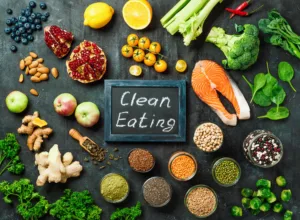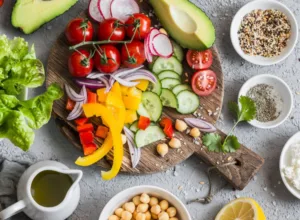The world of diets can be overwhelming. Fads come and go, leaving you wondering what’s truly best for your health. Enter clean eating: a philosophy that emphasizes whole, unprocessed foods for a balanced and sustainable approach to nutrition. But what exactly does it entail, and is it right for you?
Most people believe that clean eating is for fitness/bodybuilders or any sort of athlete when in reality, clean eating is a key component of mental and physical health. We MUST eat clean if we really want to embrace a healthy lifestyle, spirituality, and longevity.
When we discuss diet plans we can typically put them along a spectrum where food quantity is on one end and food quality is on the other.
Diets like If It Fits Your Macros (IIFYM) fall as far to the food quantity side as possible while clean eating falls as far to the food quality side as possible.
The main principles of clean eating are centered around focusing on the quality of the foods you consume and ensuring they are “clean”.
The principles can be summarized in one tenant: Choose whole, natural foods and seek to eliminate processed foods.
This comprehensive guide will equip you with everything you need to know before starting your clean eating journey.
What is Clean Eating?
Clean eating is less about restriction and more about embracing whole, natural foods. It prioritizes minimally processed ingredients, encouraging you to choose items closer to their natural state. Think fresh fruits and vegetables, lean proteins, whole grains, legumes, and healthy fats like those found in nuts, seeds, and avocados.
The core principles of clean eating include:
- Minimally Processed Foods: Processed foods often contain added sugars, sodium, unhealthy fats, and preservatives that detract from their nutritional value. Clean eating emphasizes whole foods that haven’t been significantly altered from their natural state.
- Focus on Whole Food Groups: Prioritize fruits, vegetables, whole grains, lean proteins, and healthy fats. These provide essential vitamins, minerals, fiber, and healthy fats for optimal health.
- Limited Added Sugars and Refined Grains: While occasional treats are okay, clean eating minimizes sugary drinks, processed snacks, and refined carbohydrates like white bread and pasta. These offer little nutritional value and can spike blood sugar levels.
- Reading Food Labels: Becoming familiar with food labels allows you to make informed choices. Watch out for added sugars, unhealthy fats (saturated and trans fats), and excessive sodium.
- Balanced Meals and Snacks: Aim for balanced meals and snacks that include protein, healthy fats, and complex carbohydrates to keep you feeling full and energized.
Benefits of Clean Eating
Clean eating offers a multitude of benefits that extend beyond weight loss:
- Improved Overall Health: By prioritizing nutrient-rich foods, you’ll provide your body with the building blocks it needs to function optimally. This can lead to increased energy levels, a stronger immune system, and better digestion.
- Reduced Risk of Chronic Disease: Clean eating can help manage weight, which is a risk factor for chronic diseases like heart disease, type 2 diabetes, and some cancers.
- Enhanced Mood and Cognitive Function: Whole foods are packed with vitamins, minerals, and antioxidants that support brain health and can contribute to improved mood and cognitive function.
- Healthy Relationship with Food: Clean eating fosters a more mindful approach to food. You’ll learn to appreciate the natural flavors of whole foods and develop a healthy relationship with eating.
Getting Started with Clean Eating
Transitioning to clean eating doesn’t have to be drastic. Here are some practical tips to get you started:
- Start Small: Don’t overwhelm yourself with a complete overhaul. Begin by incorporating more fruits and vegetables into your diet and gradually swap processed snacks for healthier alternatives.
- Stock Your Kitchen: Fill your pantry and fridge with staples like whole grains, legumes, fresh produce, lean protein sources, and healthy fats. Having these on hand will make clean eating easier.
- Plan Your Meals: Planning meals and snacks in advance can help you avoid unhealthy choices when hunger strikes.
- Prep Ahead: Chopping vegetables, prepping healthy snacks, and cooking in batches can save time throughout the week.
- Read Food Labels: Become a label-reading pro! This will help you make informed choices and identify hidden sugars and unhealthy fats.
- Cook More at Home: Cooking at home allows you to control ingredients and portion sizes. Experiment with new recipes to keep things interesting.
- Don’t Deprive Yourself: Restricting yourself too much can lead to cravings and overeating. Allow yourself occasional treats in moderation.
- Listen to Your Body: Pay attention to how your body feels after eating certain foods. Clean eating should leave you feeling energized and satisfied.

 The core principles of the diet can be listed as follows:
The core principles of the diet can be listed as follows:
- Avoid processed foods
- Avoid refined foods
- Avoid artificial ingredients
- Avoid alcohol
- Avoid soda and fruit juice
History Of The Clean Eating Diet
As clean eating is not a well-defined dietary program it is difficult to trace its history of it as a dieting paradigm back to a singular beginning.
Related Articles: Longevity: Increase Life Expectancy By “Eating These Healthy Foods” Recommended By Dietitians
One could give credit to the ancient Greek physician Hippocrates who penned one of the first works on dietary principles and is responsible for the famous quote, “Let food by the medicine and medicine be thy food”.
Check Out Our List Of The Best Supplements For Building Muscle, Shredding Muscle, Recovery, And Great Health, and Wellness Products! Purchase ifbnewsfeed.org‘s apparels Here: ifbnewsfeed.org
General Overview of Components & Main Principles of The Clean Eating Diet
Clean eating is based on the principle of eating whole, natural unprocessed foods.
Most proponents of clean eating will suggest it is not truly a diet, but rather a view on what to eat and what not to eat.
It focuses on food quality and not quantity, so calorie counting is not utilized in this dietary framework.
Related Articles: Healthy Meals To Lose Weight – “A Simple Plan” That Works For Anyone Who Wants To Shred Some Weights Off
Meal Timing/Frequency
On principle, clean eating does not have strict requirements for meal timing or meal frequency (read: how many times a day you eat).
However, in the application, most clean eating programs suggest people eat 5 to6 smaller, clean food, meals, and snacks throughout the day rather than 3 main meals.
Restrictions/Limitations
Clean eating places fairly substantial food restrictions on individuals. Clean eating diets require that people consume only whole, natural foods and eschew everything that is processed.
This excludes portions of pasta, pieces of bread, crackers, chips, cereals, and anything else that has been processed. This approach also excludes things like condiments (e.g. mustards and spreads) as well as dressings.
Additionally, most beverages are restricted; this includes alcohol, soda, and juice.
Related Articles: Nutrition Is A Key Factor. Here Is Everything You Need To Know About “Healthy Nutrition Plan And Fitness”
Does It Include Phases?
As traditionally thought of, the clean eating diet does not usually include phases.
Most prescriptions of the clean eating diet as instantiated in books, articles, and programs have people initiate the full spectrum of the diet at the outset. “Some even include 30-day challenges in which whole, natural foods must be consumed for the entirety of the 30 days with no deviation from the protocol”.

 Who Is It Best Suited For?
Who Is It Best Suited For?
Clean eating is best suited for people who are focused on the health properties of food, do not feel the desire to track the calories in their food, and who do not mind fairly restrictive approaches to nutrition.
Clean eating allows substantial flexibility in the amount of food one eats, the timing and frequency, and with some effort and diligence, the diet can be used for a wide range of people with drastically different goals (e.g. fat loss, muscle gain, or sports performance).
Related Articles: “The Best 8 Of the Highest-Protein Foods” Every Well-Balanced Diet Should Include
How Easy Is It to Follow?
How easy it is to follow a clean eating diet really depends on what type of person you are and your food preferences. For people who enjoy eating a wide variety of food, do not enjoy food restrictions, and would rather focus on the quantity of their food (i.e. the calories and macros) clean eating may be rather difficult to follow.
For people who are creatures of habit, do not mind eating within restricted dietary frameworks, and do not enjoy counting their calories of macros clean eating can be an excellent dietary framework to follow.
Most people who practice clean eating long-term usually build in small amounts of flexibility and follow either an 80/20 or 90/10 rule where they allow themselves to eat food on the restricted list 10-20% of the time.
Related Articles: These Are The “8 High-Protein, Low-Carb Foods” That Dietitians Recommend You Add To Your Diet
Mainstream Belief Behind Diet
The mainstream belief behind the clean eating diet is that natural, whole foods are optimal for human health and that they naturally control calorie intake.
While there are indeed sound reasons behind consuming more natural foods, one cannot truly rely on the “natural” argument as the sole basis for why this diet is effective as the naturalistic fallacy is a common logical fallacy.
Related Articles: 26 Foods That Help You Build Lean Muscle
Scientific Studies and Interpretation of Data
To date, there are no published studies examining the effect of a clean eating diet which makes it difficult to draw hard conclusions on the scientific efficacy of this diet. However, there are a few things we can glean.
Additionally, higher diet quality is associated with improved health markers and a lower risk of developing type 2 diabetes.

 Clean Eating and You
Clean Eating and You
Clean eating isn’t a one-size-fits-all approach. Consider your individual needs, preferences, and dietary restrictions. It’s always best to consult with a registered dietitian or healthcare professional for personalized guidance.
Remember, clean eating is a lifestyle shift, not a quick fix. By making gradual changes, incorporating more whole foods, and focusing on a balanced approach, you can experience the numerous benefits of clean eating and feel your best from the inside out.
Wrapping Up
Clean eating falls on the opposite end of the dietary spectrum from approaches like IIFYM or flexible dieting and focuses almost exclusively on food quality, not food quantity.
The main principles of clean eating are centered around focusing on the quality of the foods you consume and ensuring they are “clean”.
The principles can be summarized in one tenant: “Choose whole, natural foods and seek to eliminate processed foods”.
The core principles of the diet can be listed as follows: avoid processed foods, avoid refined foods, avoid artificial ingredients, avoid alcohol, and avoid soda and fruit juice.
References
- A satiety index of common foods
- Diet-quality scores and plasma concentrations of markers of inflammation and endothelial dysfunction
- Effects of a short-term intervention with a paleolithic diet in healthy volunteers
- The “4 Basics Bodybuilding Macronutrient Muscle-Building Meal Plans” On A Budget
- The “7 Top Muscle Building Nutrition Food Sources” To Gain Muscle Mass, Strength, And Staying Proactive

- A1Supplements.com – America’s Favorite Supplement Store.
- Shop Optimum Nutrition Energy: Anytime & Pre-Workout
- A1Supplements.com – Lose Fat, Gain Muscle!
For More News And Daily Updates, Follow IFBNewsfeed.Org on Facebook, Twitter, and Instagram. Comment, Like, And Share With Everyone Who May Need To Be Updated With The Most Recent Fitness/Bodybuilding/Powerlifting And CrossFit News.







